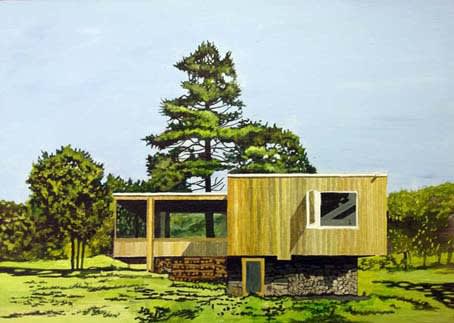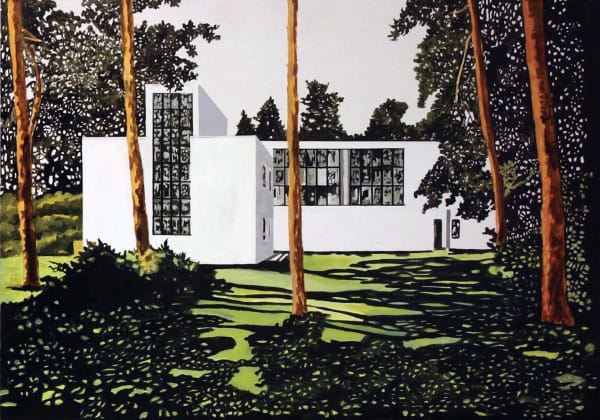Black Mirror: Josef Filipp Galerie, Leipzig, Germany
Right from the outset of his artistic career, Eamon O’Kane has preoccupied himself with existing places and buildings that reveal not only that have they been dedicated to and used for culture, but also their claims to an agenda, and which in this way have exerted a telling influence. No less important for O’Kane is the design aspect of these places and buildings, whether in the graphics for the traffic signs, in the colours and patterns of the surfaces, in the design of the furniture or the choice of materials, as well as in the style of construction.
Eamon O’Kane employs various media, such as drawing, painting, installations, photography and film, often using them serially or sometimes even combining them. Although his works clearly revolve around pre-given motifs which he reproduces, references or cites, he has developed his own artistic language.
Among the first of Eamon O'Kane's projects beginning in the late 1990s were his photographic series of cityscapes [Negative Mirror, 1996-2001] and street signs [SIGN, 2001-2005], which already contain important aspects of his work. The title Negative Mirror refers to the positive image of the ever-present person who is not, however, visible in the mirrored cityscape, while similarly the street signs thank only their potential viewers for their existence. People seem here to be both the cause and the addressee of an environment defined and determined by a specific aesthetic.
Parallel to this, O'Kane did a number of large drawings [City Panorama Series, 1998-1999] in which buildings have not only to hold their own in front of a city panorama but also find a place in this topographical pattern. This was followed by three series of paintings in which Eamon O'Kane focussed on an aspect that has left an indelible stamp on his work right to this day: the topic of the studio. With his Studio in the Woods Series, 2003/2004, Studio House Series, 2004, and Ideal Studio Series, 2004-2007, O'Kane turned his mind to the artist's house and its ideal location.
The concept of the studio has a long tradition, which O'Kane deliberately refers to. The word studio designates a creative person's workplace, a room dedicated to study and the pursuit of the arts, a place not only of work but equally of contemplation.
In his paintings Eamon O'Kane cites buildings that not only exist in reality, but that have been designed by great architects from various generations and backgrounds, such as Frank Lloyd Wright, Elam & Bray, Helmut Jahn, or Lacaton+Vassal, who all have in common a language of modernism and minimalism. These buildings have been given however a new context in the paintings, because they have been placed on their own in a wooded landscape. The modernist buildings, now quite alone in nature without any kind of infrastructure, not only become the ideal places for seclusion, but also seem to be exposed to the wilds without any form of protection. In this way O'Kane's pictures combine the ideas that have constantly been handed down to us of the ideal building in Modernism, and of the artist as lonesome genius.
But Eamon O'Kane is not only concerned with buildings which [can] mutate through their form or their surroundings into artist's houses, but also with genuinely existing artist's houses, which he depicts in models or excerpts. At the same time he is interested in the fundamental artistic question of form and content. Because an artist's house is not only a place for producing art, but also a place whose design reflects the artist's image of his-or herself.
With Eames Studio Limerick, Eamon O'Kane has developed an enclosed space from a wooden construction whose walls are covered over by coloured paper. Here he cites in model form the house and studio that the designer and architect couple Charles and Ray Eames built in 1949 on the coast of Los Angeles. The Eames House, also known as Case Study House No. 8, was done as part of a commission for twenty-five such Case Study Houses, which were published in John Entenza's Arts & Architecture magazine. The white facade with its black geometrical frames and coloured wood panels is reminiscent of a composition by Mondrian. Surrounded by trees, the house served as a living space and a place of study, and was full of design objects and works that the two of them had collected.
Eamon O'Kane reflects in this work on the importance of Charles and Ray Eames, who not only set new standards in architecture and design, but were also active in the fields of photography, exhibition design, and multimedia-presentation. O'Kane has also taken over as it were these realms for his house.
The Eames Studio Limerick consists of two rooms that are connected with one another, but also have their own entrances. One room is designated as the archive and document room. Drawing on the house by the celebrated husband and wife architects, it contains source material relating to the development of architecture and design from the twentieth century to the present. It is a space for reflection and research, for reading their writings or viewing their films. The second space serves as a workshop and simultaneously a place of education. Here we find source images as well as construction and drawing materials, and games developed not merely for children by Friedrich Fröbel and Charles and Ray Eames.
Like his model, Frank Lloyd Wright, Charles Eames was brought up according to the Fröbel Method. The German educationalist Friedrich Fröbel [1782-1852] was one of the pioneers of pedagogy, who placed play at the centre of his teachings as a typical childhood activity that is of great educational value. His »play-gifts« and teaching material continue to be acknowledged to this day, including the basic pedagogic forms he developed of the sphere, cylinder and cube, which are still employed. Fröbel's construction blocks and movement games were also a source of inspiration for abstract artists and the Bauhaus movement.
This symbiotic play between architecture, art, design and theory based on historical models is continued in O'Kane's pieces A History of Play: Froebel Studio and A History of Play: Froebel Eames Studio, and likewise in 2011 in the piece Cardboard Modernist Furniture Workshop.
His interactive work Cardboard Modernist Furniture Workshop consists of a room that is dominated by wall elements and objects that reference the architecture of Frank Lloyd Wright and Le Corbusier, the painting of Piet Mondrian, and the furniture of Charles and Ray Eames. Posters show design objects, and cardboard and tools have been placed on tables as construction materials that the visitors can use.
Also to be mentioned in connection with Eamon O'Kane's studio works is his Architect's Study, a walk-in architectural model consisting of a simple open wooden construction done according to the Glass House by Philip Johnson, which like the Eames House was also made in 1949. The architecture, consisting simply of glass walls and one sole room, defied the traditional idea of a residential building.
On show in Eamon O'Kane's installation-which can be looked in to from all sides and has no further furnishings-is a film consisting of a succession of paintings by the artist in a loop, all showing the Glass House in a pristine natural setting. This ensemble is augmented by paintings with further buildings by Philip Johnson, which have also been placed in nature.
All of the three-dimensional works that Eamon O'Kane has developed here not only theme particular architects, but also transpose the cited situations to his own artistic procedure. The references he makes to architecture are themselves buildings: the paintings and the walk-in installations grant experiences and activities that parallel those of their real models. Thus the »studios« become a stage for the visitor, because only by actively using the materials, such as the play-gifts, documents and films, is the artwork's potential exhausted. These are interactive locations that turn the visitors into an integral part of the installation. And not only do the visitors look and act of their own accord, they are also observed in turn in their activities, thus making them recipient and actor in one, so that at all times the relationship between the subject and the exterior is exhibited as well.
It is interesting how a tight concurrence can take place inside the artwork of things that normally happens in a sequence: viewing the artwork, using it, experiencing and conveying it all take place simultaneously at the same location.
In this way the studios are not simply reproduced as studios, but also used as studios through the interaction of the visitors. This idea of bringing analytical insight simultaneously together with physical experience is one of the main aims of Eamon O'Kane's conceptual works, with which he also comments on the art of the sixties. A further strategy in Eamon O'Kane's creative output that should not go unmentioned is adoption, along the lines of appropriation art. Under this aspect come not only the modified citations from the buildings, but also the integration of the original play-gifts. O'Kane's works, with their documentary resources, could also be referred to as archives or research-based-projects. They are participative in the sense that the audience can change the work by using the materials placed at their disposal. The straightforward boundaries between production and reception have become permeable.
The aspects ranging from a clearly defined artwork to the permeability of the same, from passive, contemplative reception to an active form of reception that takes part in the exhibition, from a situation as a neutral frame that delimits the object from everyday life to interventions in public space-all of these typify Eamon O'Kane's work. His works transform into places that are marked by cooperation and communication between subject and object: they are in fact social entities.
-By Angelika Nollert
_______________________
Dr. Angelika Nollert is director of
Die Neue Sammlung Munich - The International Design Museum Munich,
at the Pinakothek der Moderne in Munich and Neues Museum Nuremberg
and of the International Keramik-Museum in Weiden/Upper Palatinate
[branch museum of Die Neue Sammlung].
https://www.filipp-galerie.com/en_kuenstler,eamon_o´kane,17.html
-
 Eamon O'Kane, Walter Gropius Master House with Shadows, 2015
Eamon O'Kane, Walter Gropius Master House with Shadows, 2015 -

-

-
 Eamon O'Kane, Case Study House, Richard Neutra (Black mirror), 2016
Eamon O'Kane, Case Study House, Richard Neutra (Black mirror), 2016 -
 Eamon O'Kane, Villa Tugendhat Interior (black mirror), 2013
Eamon O'Kane, Villa Tugendhat Interior (black mirror), 2013 -
 Eamon O'Kane, Double Portrait (Black Mirror Series), 2016-2024
Eamon O'Kane, Double Portrait (Black Mirror Series), 2016-2024 -

-

-

-

-

-

-

-

-
 Eamon O'Kane, Workers Dessau (black mirror), 2016
Eamon O'Kane, Workers Dessau (black mirror), 2016 -
 Eamon O'Kane, Walter Gropius Master House Dessau Stairwell, 2016
Eamon O'Kane, Walter Gropius Master House Dessau Stairwell, 2016


















